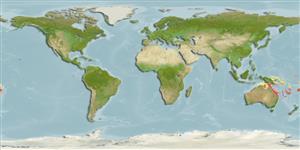>
Eupercaria/misc (Various families in series Eupercaria) >
Labridae (Wrasses) > Bodianinae
Etymology: Choerodon: Greek, choiros = a pig + odous = teeth (Ref. 45335); referrring to the prominent anterior canines of the species in this genus (Ref. 116605).
Environment: milieu / climate zone / depth range / distribution range
Écologie
marin récifal; profondeur 15 - 40 m (Ref. 86942). Tropical
Western Pacific: Philippines, Queensland, Australia to New Caledonia.
Taille / Poids / Âge
Maturity: Lm ? range ? - ? cm
Max length : 51.5 cm TL mâle / non sexé; (Ref. 5525)
Épines dorsales (Total) : 13; Rayons mous dorsaux (Total) : 7; Épines anales: 3; Rayons mous anaux: 10. Body with about 5 to 7 complete broad dusky bands. A distinct dark spot centered on lateral line along dusky band below fifth or sixth dorsal-fin spine. Adults with second prominent anterior canine approximately 1/2 the size of the first, directed mostly dorsally. (Ref 9823)
Adults inhabit lagoon and seaward reefs, usually on rubble and sand bottoms (Ref. 9710) at depths greater than 20 m. Solitary. Feed mainly on hard-shelled prey including crustaceans, mollusks and sea urchins. Oviparous, distinct pairing during breeding (Ref. 205). Relatively common and easily approached (Ref. 9710).
Life cycle and mating behavior
Maturities | Reproduction | Spawnings | Egg(s) | Fecundities | Larves
Oviparous, distinct pairing during breeding (Ref. 205).
Westneat, M.W., 2001. Labridae. Wrasses, hogfishes, razorfishes, corises, tuskfishes. p. 3381-3467. In K.E. Carpenter and V. Niem (eds.) FAO species identification guide for fishery purposes. The living marine resources of the Western Central Pacific. Vol. 6. Bony fishes part 4 (Labridae to Latimeriidae), estuarine crocodiles. FAO, Rome. (Ref. 9823)
Statut dans la liste rouge de l'IUCN (Ref. 130435)
Menace pour l'homme
Harmless
Utilisations par l'homme
Pêcheries: intérêt commercial mineur; Aquarium: Aquariums publics
Outils
Articles particuliers
Télécharger en XML
Sources Internet
Estimates based on models
Preferred temperature (Ref.
123201): 24.5 - 26.6, mean 26.1 °C (based on 42 cells).
Phylogenetic diversity index (Ref.
82804): PD
50 = 0.5000 [Uniqueness, from 0.5 = low to 2.0 = high].
Bayesian length-weight: a=0.01698 (0.00689 - 0.04188), b=3.03 (2.81 - 3.25), in cm total length, based on LWR estimates for this (Sub)family-body shape (Ref.
93245).
Niveau trophique (Ref.
69278): 4.3 ±0.0 se; based on diet studies.
Résilience (Ref.
120179): Faible, temps minimum de doublement de population : 4,5 à 14 années (Preliminary K or Fecundity.).
Fishing Vulnerability (Ref.
59153): Moderate vulnerability (41 of 100).
Nutrients (Ref.
124155): Calcium = 34.4 [16.9, 61.0] mg/100g; Iron = 0.469 [0.255, 0.921] mg/100g; Protein = 18.5 [15.6, 20.9] %; Omega3 = 0.109 [0.066, 0.177] g/100g; Selenium = 32.3 [16.9, 63.8] μg/100g; VitaminA = 67.7 [17.0, 325.4] μg/100g; Zinc = 0.894 [0.598, 1.432] mg/100g (wet weight);
